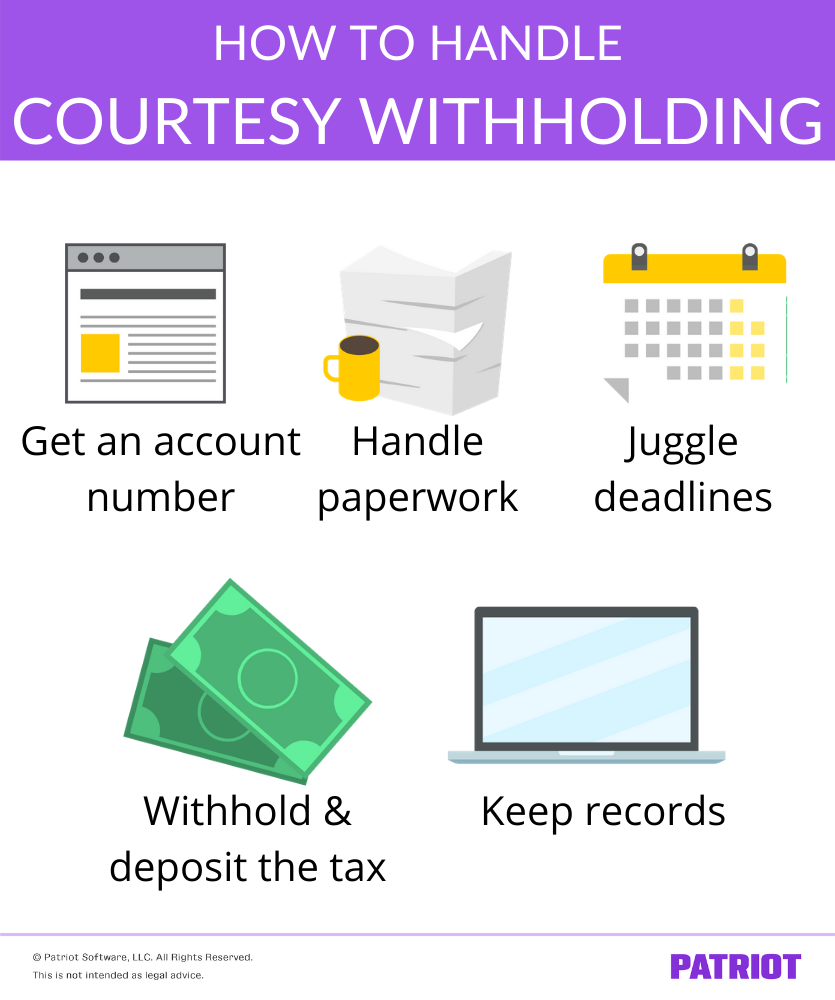Do your employees live in a different city than the one they work in? Does that city have local income tax? If so, you might consider implementing courtesy withholding to simplify your employee’s tax responsibilities.
Read on to learn what is courtesy withholding, how you can establish it in your small business, and your responsibilities if you do.
What is courtesy withholding?
If employees reside in one city and work in another, they may be required to pay local taxes for both cities. Courtesy withholding is an optional benefit where employers collect local income tax for employees who live in another city. Through courtesy withholding, employees don’t need to pay local taxes separately, as the employer deducts these amounts and pays them on the employee’s behalf.
Let’s say an employee has local income taxes in both the city they work in and live in. If you offer courtesy withholding, you would be responsible for withholding and remitting these taxes for the employee to both cities.
Local income tax is just one type of income tax that taxpayers might be responsible for. As an employer, you also withhold federal income and possibly state income taxes from employee wages.
If your employee lives in a different state, you can also do courtesy withholding for state income taxes.
Courtesy withholding vs. tax reciprocity
The city or state your business is located in may have a reciprocal tax agreement with the employee’s home city or state.
Tax reciprocity agreements mean that taxpayers are exempt from paying state or local income taxes to their employment state or city and instead only pay to their home state or city. There are a number of states with tax reciprocity agreements. For example, Ohio has tax reciprocity with Indiana, Kentucky, Michigan, Pennsylvania, and West Virginia.
Courtesy withholding comes into play if your business is located in a state or city that does not have a tax reciprocity agreement. As the employer, you can choose to withhold state or local income tax from the employee’s wages and submit the tax to their state or locality.
Implementing and carrying out courtesy withholding
If you decide to offer courtesy withholding to employees, you have to do a little bit of footwork. You must:
- Apply for an additional account number with the city or state
- Deal with more paperwork (e.g., tax forms)
- Juggle additional deposit deadlines
- Withhold and deposit the tax with the state or locality
- Keep accurate records

1. Getting an account number
First things first: you must create an account and obtain an account number with the locality (or state) you’re doing the courtesy withholding for. Many states and localities let you create a tax account online.
If you have employees living in different cities, you may need to manage multiple accounts.
For example, you might have three employees in different cities, plus an account for the local tax for the city your business is located in.
2. Handling paperwork
No tax-related responsibilities would be complete without the proper paperwork. Like federal, state, and work location-based local income taxes, you must file tax forms with the employee’s home locality.
These forms show how much the employee earned during the period and how much you withheld in taxes.
3. Juggling deadlines
Offering courtesy withholding means you have one more tax deposit deadline to stay on top of. Check with the employee’s residential locality (or state) to learn when deposits are due. The city determines how often you need to deposit the taxes (e.g., quarterly) and the deadlines.
To avoid missing deadlines, consider setting a reminder for yourself.
4. Withholding and depositing the tax
Before you can withhold the tax from employee wages, you need to know how much it is. Some localities use a flat percentage rate that applies to all workers. Other localities use a progressive tax rate, meaning individuals who earn more pay more.
Consult the employee’s locality to find out which tax rate it uses and how much it is. Then, withhold that amount from the employee’s wages.
To simplify your responsibilities, consider using payroll software. That way, the software can calculate the employee’s local income tax for their residence (and you don’t have to).
5. Keeping records
Remember to keep up-to-date and detailed information for your records. Make copies of pay stubs, tax forms, and any other documents relating to the courtesy withholding. Store digital records, paper records, or both.
Tired of complicated payroll systems? Run payroll in three steps with Patriot’s online payroll. It’s fast, simple, and affordable … and who doesn’t want that? Get your free trial now!
This article has been updated from its original publication date of May 18, 2012.
This is not intended as legal advice; for more information, please click here.


